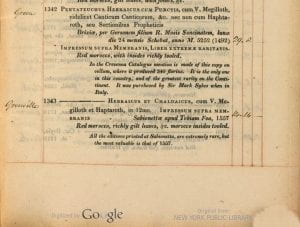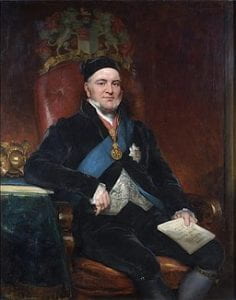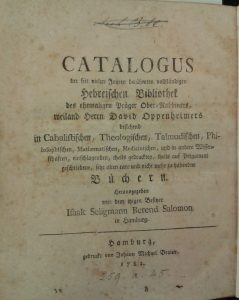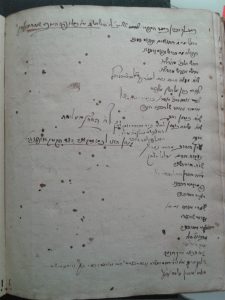The April 20, 2020 New Yorker has a fascinating article by Rebecca Mead on everyone’s favorite ex-royals, Meghan and Harry, that compares their unconventional relationship with the rest of the royal family to that of the first Duke of Sussex (Harry is the second Duke), Prince Augustus, sixth son of King George III. If you read the article, you were probably drawn, like me, to one of the really interesting facts about Augustus–that he “amassed a large library of valuable books and manuscripts at his apartments in Kensington Palace” and that “he owned a collection of sixteenth-century Hebrew Bibles, and studied them with a tutor.” Mead leaves off here talking about Augustus’ library and his early Hebrew printed books to turn to his two marriages contracted without royal consent (and thus semi-scandalous by early nineteenth century standards).

Thomas Pettigrew (without the mummies) (Wellcome collection; https://wellcomeimages.org/indexplus/image/M0000726.html)
The New Yorker doesn’t have footnotes, or Mead might have referred you to the catalogues of Augustus’ book collection to see the extent of his collection yourself. In 1827, the Duke’s personal librarian, Thomas Pettigrew (1791-1865) crafted a two-volume Bibliotheca Sussexiana , a partial catalogue with notes on the Hebrew, Greek, and Latin Bibles, which he followed up with a second volume in 1839, covering the Bibles in other languages including not only English, German, French, and Italian but also Coptic, Arabic, Slavonic, and so forth. In the preface to that volume, Pettigrew expresses his regret that he wasn’t able to complete a catalogue of the entire vast library or even just the biblical portions in a timely way: “I could have wished to have been able to devote my time to the completion of this memorial of a portion of its entirety; but my first duty has been exercised upon objects of a different nature, and my professional avocations demand all the time it is in my power to command.” Indeed, Pettigrew was a busy man: he was also a surgeon, anatomy professor, freemason, antiquarian, and book collector in his own right. The “objects of a different nature” were most likely understood by those in his social circles to mean mummies. He was Victorian England’s best-known amateur Egyptologist and was famous for throwing parties where he would unroll and then dissect mummies for his guests. A few years later, others got to work on another catalogue of a large part of the collection, published also under the Biblioteca Susexiana title (now a brand?) in 1844.
So what happened to the Duke’s 50,000 books and manuscripts? They were actually locked away in the Kensington Palace attic in crates labeled “property of the Duke of Sussex” and presented to Harry and Meghan after their wedding. The books were supposed to be shipped last month to the new library that the former royals are building at their vacation home on Vancouver Island, but the pandemic is holding things up.
Had you going, right? Actually, the books were sold at auction in 1844 (the occasion for that other catalogue) and are now scattered in library collections around the world.
The Duke and his collection had made two appearances in Footprints before Mead’s article caught my eye and led me to take a closer look. One footprint tells us that Augustus’ interest in Hebraica went beyond Bibles. Indeed, the Prince-Duke was keeping up with relatively recently published rabbinic works: his library included a copy of responsa and novellae on the Talmud tractate Rosh Hashanah by Judah Loeb Margolioth (1747-1811), rabbi in Frankfurt der Oder and author of halakhic and ethical treatises. This copy of Sefer Korban Reshit printed in 1777 made its way from the Duke of Sussex to renowned Judaica bibliographer Shimon Brisman who eventually sold it to Washington University in St. Louis. The Duke of Sussex’s book plate from this volume can be found here, from an on-line exhibit of the Brisman Collection at Washington University.

Bibliotheca Sussexiana: the Extensive And Valuable Library of His Royal Highness the Late Duke of Sussex, K.G. &c. &c. … Which Will Be Sold by Auction by Messrs. Evans, No. 93, Pall Mall. (London, 1844) University of California copy (via Hathitrust)
I wanted to see how the Duke’s auctioneers (Messrs Evans, no 93, Pall Mall) described this book so I turned to the published catalog of 1844. I was surprised not to find it there. Although this first volume of Biblioteca Sussexiana purportedly includes all of his Bible and theological works, it also lists over 200 works by “rabbinical authors.” Yet Margolioth’s Sefer Korban Reshit seems to be missing. Although two later volumes were meant to be published (one covering manuscripts and the other covering “History, Antiquities, Topography, &c), these are not extant. The upshot: we can’t say for sure whether Augustus’ copy of Sefer Korban Reshit was sold in 1844.
Another thought comes to mind: most of the “rabbinical” works listed in the 1844 catalog are by famous Jewish–and Christian–authors who were part of a standard Hebraist curriculum. Sefer Korban Reshit was a fairly recent book and the author was not one that would have been well-known among the gentleman bibliophiles of 1840s London. Could this be the tip of an iceberg of recent seforim of the late eighteenth and early nineteenth century acquired by the bibliomaniac and Hebrew superfan Duke and then sold off at some later point in large lots to Jewish bookdealers in less fashionable parts of London? The two other pre-Brisman footprints indeed suggest that this book-copy spent some time away from the rarefied world of Kensington Palace in Jewish circles: The first of these derives from a book stamp in Russian from 1837 with the name “V.A.M. Ravin.” A censor? A Jewish owner? (For now, the closure of the Washington University Library in the pandemic prevents further examination.) Did the Duke acquire this late in his life–after 1837? or was it “deaccessioned” by Augustus and Pettigrew in 1837? We also have a signature of an “Aharon Zitits” who owned this book at some point. Before 1837 or after 1844? More work remains to be done here.

NYPL **P (Bible. O.T. Pentateuch. Hebrew. 1482) photo: https://footprints.ctl.columbia.edu/footprint/10661/
The second footprint is more in line with the Duke’s interest in early printed Bibles: here is a footprint where we can see his bookplate in a copy of the Bologna Pentateuch of 1482 at the New York Public Library, one of the earliest printings of the Hebrew Bible, the first with vocalization and the first with Rashi’s commentary. And it’s a book that still has a wow factor: Christie’s sold another copy of this in 2014 for $3.87 million. We know from another bookplate in the NYPL copy of this book that this was also owned by William Stuart who had a library at Tempsford Hall, a country home in Bedfordshire, England. Eventually the book was sold again to the Lenox Library, one of the predecessors of the current NYPL.
The Duke apparently obtained his copy of the Bologna Pentateuch from Luigi Celotti (c. 1765-1846), an abbot turned bookdealer originally from Venice. Celotti was famous (or infamous) for selling looted books and art in Venice, Florence, and London. In 1825, Samuel Sotheby, the forerunner of the famous auction house, handled multiple sales for Celotti, including a sale of his Hebrew, Greek, and Latin manuscripts, his Italian and Spanish printed books, and manuscripts (including Hebrew) from the libraries of Matteo Luigi Canonici and the Saibante family. None of these seem to be the source of this copy, so we need some more research to track down the earlier provenance of the Celotti-Sussex-Tempsford Hall-NYPL Bologna Pentateuch copy and the point at which Sussex obtained the book from Celotti.
We might also need some more research to figure out the post-Sussex provenance as well–and here is where things get even stranger: once again, I could not find this book in either the 1827 Pettigrew work or the 1844 auction catalog. So we have evidence of two books that undoubtedly belonged to the Duke (the bookplates are pretty clear), but left the Kensington Palace library in some other way than the prominent auction held after the Duke’s death. I think my scenario above for Sefer Korban Reshit is plausible. But we need a different explanation here. And right now I don’t have one.
So, more to come. On one side, we can enter “historical copy” footprints from the Biblioteca Sussexiana volumes; on the other end, I expect we will find more from this collection now in various library collections as we look at extant books, current library catalogs and later auction catalogues. We also have at least two data points to suggest that books were being sold off through other venues than the Evans auction house.
Even more mysteries: I took a short break from writing this blog post to enter the 1844 sales footprint for the first pre-1800 Hebrew Bible listed in the Biblioteca Sussexiana catalog, lot #2. This is a Pentateuch with Five Megillot and Haftarot, printed by Foa in Sabbioneta in 1557. The 1844 auction catalog tells us it was printed on vellum and was previously owned by “Rev. T. Williams.” Thanks to social media quick help from an expert on where Hebrew books were coming and going in the nineteenth century, Noam Sienna, I was able to find that the library of the Reverend Theodore Williams was auctioned in April 1827. A copy of that auction catalogue now at the New York Public Library (and digitized here) even has handwritten notations of buyers and prices paid!

detail from NYPL copy (via Hathitrust) of A Catalogue of the Library of the Rev. Theodore Williams:…[London, 1827.]
What about the current whereabouts for this copy that went from Theodore Williams maybe to Thomas Grenville and definitely to the Duke of Sussex and not the British Library? I have a very preliminary candidate: Cambridge University Library’s catalog lists a copy of this “on vellum” but without provenance information. So let the hunt begin!





Recent Comments